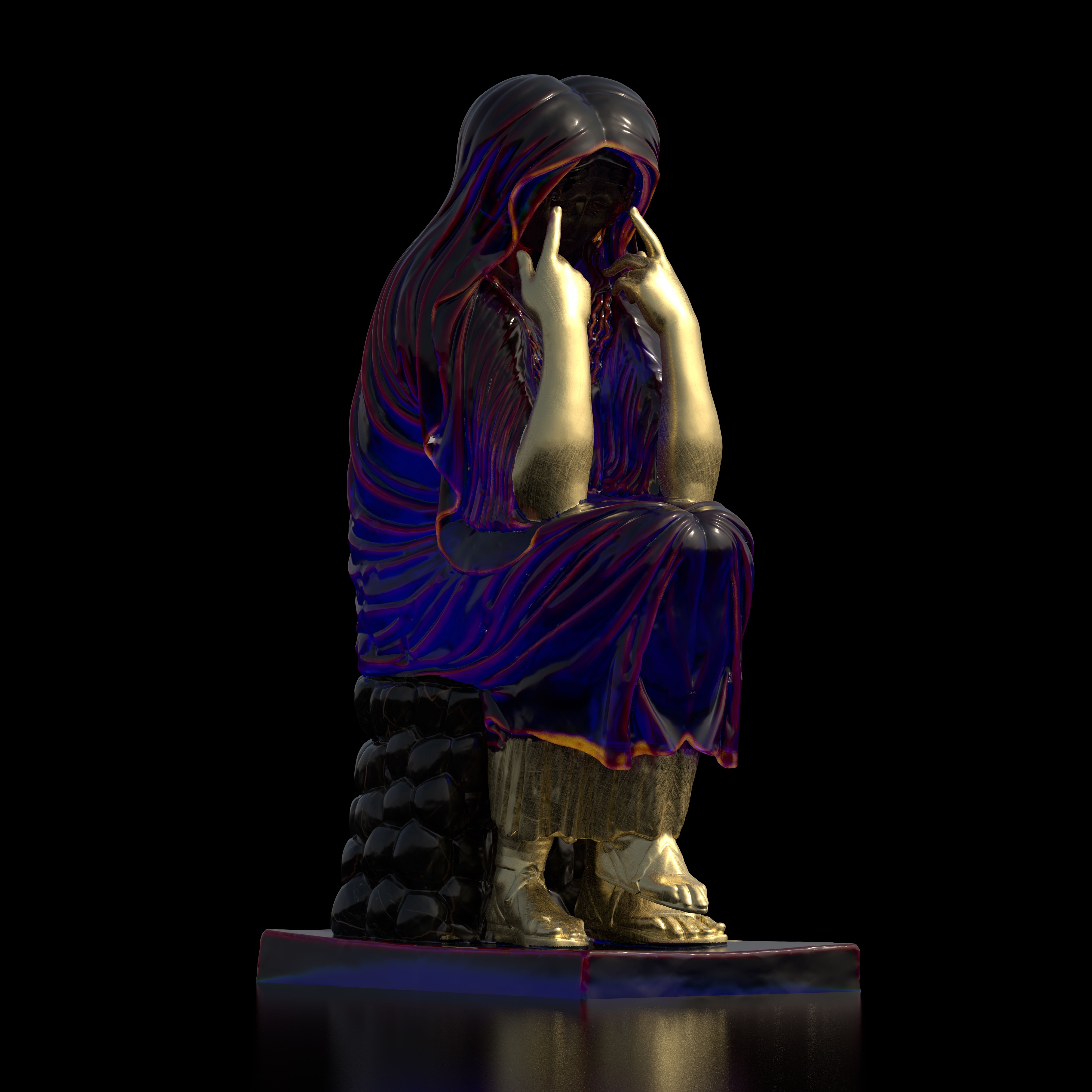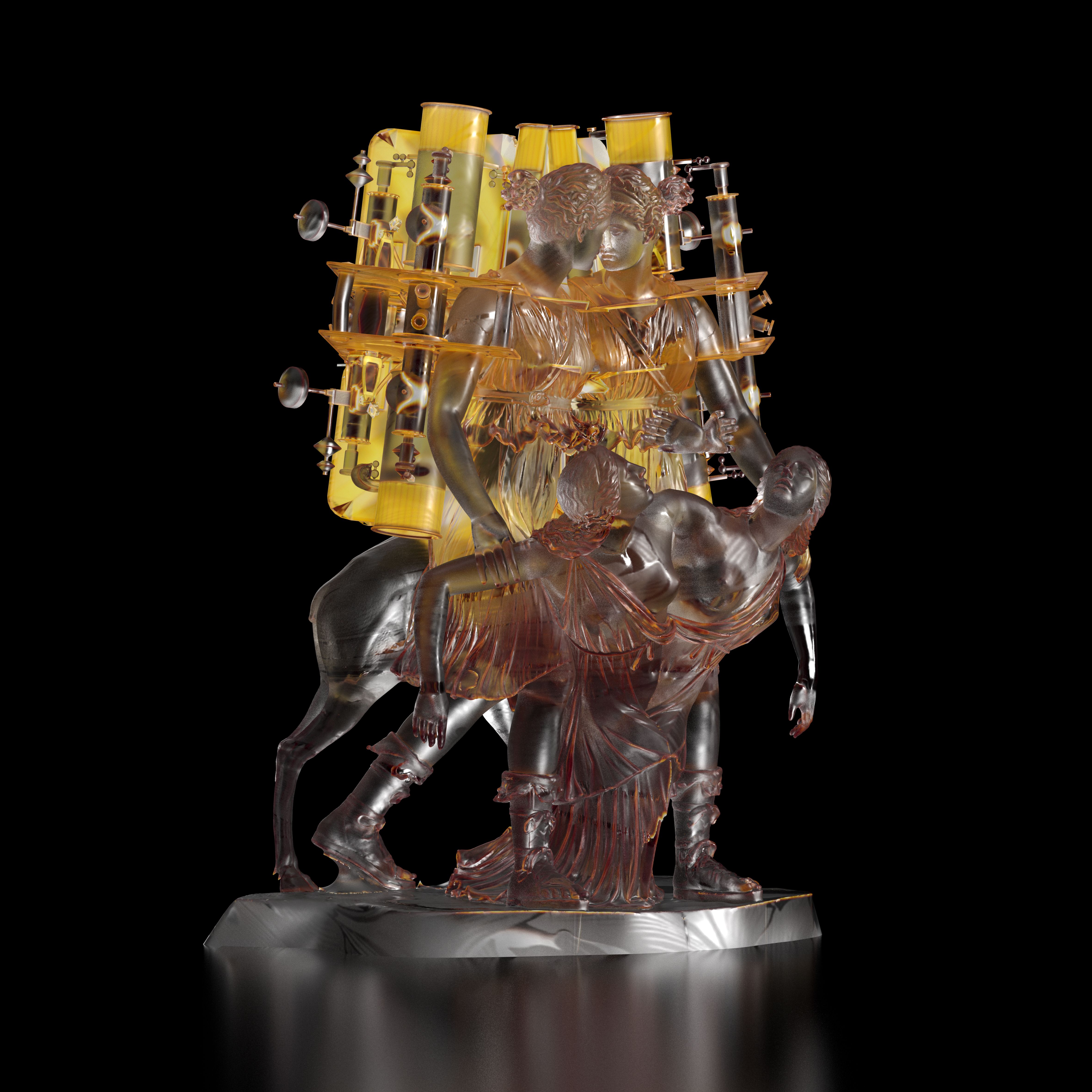
The artist and philosopher Wolfe von Lenkiewicz has carved an utterly unique space in the environs of contemporary art. His intricate, and sometimes vast, paintings grace collections all over the world, and draw upon an encyclopaedic knowledge of art history in order to re-engineer its DNA – melding the contemporary and the classical together in a meta-space where Warhol meets Picasso, Pokémon characters inhabit the Garden of Earthly Delights and Napoleonic soldiers discover a UFO in a Brueghel landscape. Given his penchant for transmogrifying classical art into post-modern future potentialities, it’s perhaps unsurprising that he has taken to the meta-verse with considerable verve. His current undertaking brings his passion for genetically re-engineering the past into the crypto-universe with a collection, or ‘project’ of 10,000 super real digital sculptures entitled The Treasury, which fluidly melds antiquity with the hyper-modern via cutting-edge creation tools.Here the artist speaks to Culture Collective about his adoption of the metaverse, the impact of crypto-currency and NFTS upon the art world, and his hopes and fears for the advent of trans-humanism.
Where would you say you sit in a tradition of art history? What drives you as an artist?
It has often been a cliché to understand the artist in regards to a 19th century model of the dissipated anarchic bohemian who burns their poetry to keep warm in the garret and drinks themselves to death, or even better, dies of tuberculosis in the process. If there are other trends in which artists have been perceived throughout the centuries, I definitely chime better with that of a renaissance humanist, Leon Battista Alberti. The difficulties of defining who we are as human beings and the questionable nature of what our purpose is in life is in this mode of thought determined by extreme discipline. The artists of the renaissance were defined by restraint of emotion, athleticism, and multi-layered interests. All of which combined the full mental and physical capacity of what it is to be human.

Tell us about the work you are creating in The Treasury…
The works all utilise 3-D scans of iconic artworks existing in the greatest collections in the world. These creations are reconfigured according to x, y and z coordinates with various code to revise their original forms, whilst also hand-crafting them and maintaining a great deal of their original geometries. It is important that the end result of this process creates something entirely unique and different from the original sculptures, and yet carries forward some of the original beauty of The Masters, which include artists such as Phidias, Lysippus, Polykleitos; and, going into different centuries, Michelangelo, Bernini and even Canova. Essentially, the meaning of the work may be defined within this Euclidean framework, retracing steps back through post-modernist ideas.
In what sense is The Treasury Euclidean? What is significant about the geometry?
The sculptures use symmetry – not a basic symmetry such as mirroring, but a far more complex one that still maintains a central axis of equilibrium. One can take any one of the 10,000 sculptures that are being made for The Treasury, and if they are placed down the centre of their central axis, they will make other unique sculptures. The entire 10,000 works in the Treasury collection, when combined form a perfect sphere, representing the world as a symbol of our own community. When broken apart they become sculptures representing the individuals of that community.

What made you want to engage in the digital space in this way?
The engagement between the contemporary arts and NFTs is an interesting cultural development – it’s much like how in the early Renaissance, Italian artists who were more used to painting in egg tempera or fresco slowly adopted the oils that were being employed by painters in The Netherlands. The new tools of oil paint enabled a new class of buyers, such as the merchant, to have small donor paintings made, rather than art only being made exclusively for kings and popes. Similarly today, communities and decentralized autonomous organizations can create democratic pools that enable the buying of art for the many rather than the few.
When did the idea of creating The Treasury begin to take shape in your mind?
The notion of The Treasury project really came about in a perfect storm, when I became immersed in the new tools that became available to artists in the form of complex 3D software such as ZBrush, Cinema4D, Substance Painter and high-resolution renderers such as Arnold.This occurred at exactly the same time as the Blockchain developed, which was another development I found hugely exciting. However, initially in the contemporary art world it was difficult to make a bridge between the two. The dealers and collectors didn’t seem to be ready to be acquiring art and going through the then complex process of setting up wallets and buying Ethereum, and so on.Things changed rapidly after the Beeple sale, and, at this point, I decided that a far more democratic way to develop my ideas was to create a project rather than one-off art works. However, the idea was to make each artwork of The Treasury project genuinely unique and as close to a one-off artwork as possible. That is to make 10,000 artworks all of which are not made with a. simple piece of coding, but are instead rendered individually in 3D programs.

Do you think NFTs are genuinely transforming the art market?
Galleries are beginning to find the NFT space legitimate beyond its obvious potential for commercial success, and leading galleries in the art market have begun to adopt NFTs into their curatorial programs. The lack of transparency of traditional art has been a problem for the contemporary art world. It has long been a problem in the art market for dealers and gallerists that work in the ‘meat space’ to know whether the art is a forgery and what its provenance is – digital art in the form of NFTs can satisfy this important criteria. Additionally, the metaverse can act as a vast cultural world for those that do not live near the largest depositaries of art such as The Louvre in Paris or The MET in New York. The meta-verse can enable intense, emotive and intellectual experiences for people to whom those real spaces seem distant. It is exactly this kind of democracy that The Treasury seeks to embrace.
How do you envision the advent of AI–do you believe in guided evolution?
Transhumanism does fascinate me, although perhaps there is a category mistake and serious flaw in the idea of human and machine. It may not simply be the case that one can reduce thought to a neural network that can in turn be remapped in the format of computer code and storage. To take the mind and download it, as it were, onto the cloud is not only technologically distant from us, but also maybe a misconception in itself, where science and philosophy fundamentally disagree. Language may not be centralised in a place such as the brain or reducible to materiality, but rather exists neither inside nor outside the world, as a shared series or rules that we all follow. Personally, I try not to take a materialist position where everything may be reduced to an atomic formula, and try to understand the mind in a non-Cartesian way, but rather as a phenomenon.
All images from The Treasury courtesy of the artist.